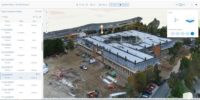Esri President Jack Dangermond and Autodesk CEO Andrew Anagnost on July 18 promised more data interoperability between geographic information systems (GIS) maps from Esri and the CAD and building information modeling (BIM) 2D and 3D models used by Autodesk AEC customers to design buildings and infrastructure and manage project delivery.
On June 17, Esri announced direct-read support in the latest version of its flagship GIS product—ArcGIS Pro—for BIM and CAD elements in road, rail and site modeling workflows that incorporate Autodesk technology. This is the first time that elements of Autodesk authoring tools such as Civil 3D and Revit Toposolids have been able to be used in another company's products. It's part of a partnership first announced in 2018 between the two companies to share their data across platforms.
"We've done foundational work, we've done the product integration work, we've done the file-level work, where we're actually doing database-level integrations," Anagnost said at Esri's recent user conference in San Diego. "You can edit the GIS data inside of AutoCAD. We've absorbed the workflows of ArcGIS into what we do; these are important, foundational things... The next step is now working on specific workflows that deliver specific value for specific types of customers."
Anagnost said transportation engineers, architects and construction professionals are three classes of those customers.
"We're building personal relationships at the engineering level," Dangermond said. "ArcGIS GeoBIM [Esri's GIS-to-BIM translator product] is cloud-to-cloud integration. What we saw this week was our customers are starting to embrace the whole of this cloud strategy and link their stuff to it."
Anagnost added that what comes out of the partnership in the coming years will be a combination of top-down workflows that the two companies have identified and from customer questions and the workflows engineers and architects have made for themselves.
"You've seen some of the things we've done with road workflows where we've integrated data that's kind of no longer in the file, but kept in other places and that data comes in and impacts the design, but doesn't doesn't weigh down the design. More of that's [coming]," he said.
Both Anagnost and Dangermond said that aside from vendor relationships with Microsoft and AWS, the vertical-to-vertical relationship between Autodesk and Esri is the most important one with the most resources devoted to it in their respective companies.
Adam Horn, HNTB's section leader for civil integrated solutions—and who spoke at the conference—said that such integrations are necessary not only for HNTB's digital transformation, but for the industry's as a whole.
"Integration without translation is a thing that we strive for at HNTB," Horn said. "CAD and GIS have historically been stovepiped. We have designers doing design, planners doing planning. We're saying if we can create an integrated infrastructure framework—which we've not been able to do in the past, because they were somewhat disconnected workflows—this new framework allows us to provide a better design and planning experience."
Horn also said that having multiple views of a transportation project—such as an overhead 2D view available in a GIS map with layers as well as a 3D, close-up view with project details in a BIM model—is what HNTB's engineers require today and will be part of the eventual workflow that will emerge from this digital transformation.





